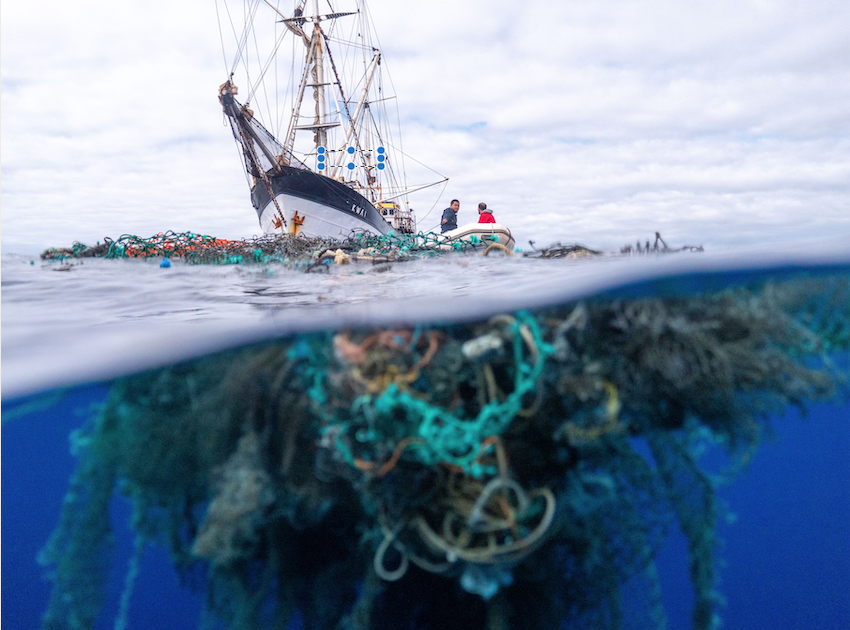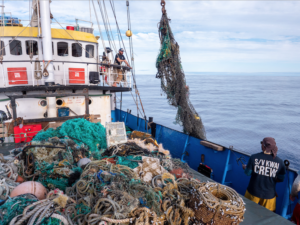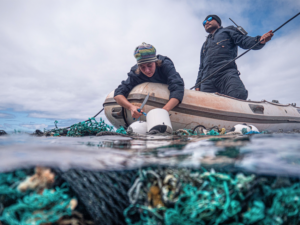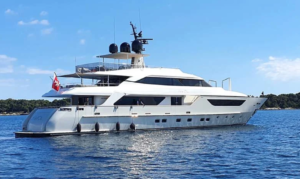Ocean Voyage Institute collects 103 tons of fishing nets

After a 48-day expedition, Ocean Voyages Institute’s marine plastic recovery vessel, S/V KWAI, successfully removed 103 tons of fishing nets and consumer plastics from the North Pacific Subtropical Convergence Zone, more commonly known as the Great Pacific Garbage Patch or Gyre.
Establishing its lead in open ocean clean-up, Ocean Voyages Institute has set a new record with the largest at sea clean-up in the Gyre to date, more than doubling its own results from last year.
“I am so proud of our hard working crew,” says Mary Crowley, founder and executive director of Ocean Voyages Institute. “We exceeded our goal of capturing 100 tons of toxic consumer plastics and derelict ‘ghost’ nets, and in these challenging times, we are continuing to help restore the health of our ocean, which influences our own health and the health of the planet.
 “The oceans can’t wait for these nets and debris to break down into microplastics which impair the ocean’s ability to store carbon and toxify the fragile ocean food web.”
“The oceans can’t wait for these nets and debris to break down into microplastics which impair the ocean’s ability to store carbon and toxify the fragile ocean food web.”
Crowley is renowned for developing effective methods to remove significant amounts of plastics out of the ocean, including 48 tons of toxic plastics during two ocean clean-ups in 2019, one from the Gyre and one from the waters surrounding the Hawaiian islands.
“There is no cure-all solution to ocean clean-up. It is the long days at sea, with dedicated crew scanning the horizon, grappling nets, and retrieving huge amounts of trash, that makes it happen,” says Locky MacLean, a former director at Sea Shepherd and ocean campaigner in marine conservation for two decades.
The GPS satellite trackers used by Ocean Voyages Institute since 2018 are proving Crowley’s theory that one tracker can lead to many nets. The ocean frequently sorts debris so that a tagged fishing net can lead to other nets and a density of debris within a 15 mile radius.
The Pacific Gyre, located halfway between Hawaii and California, is the largest area with the most plastic, of the five major open ocean plastic accumulation regions, or Gyres, in the world’s oceans.
“We are utilising proven nautical equipment to effectively clean up the oceans while innovating with new technologies,” says Crowley. “Ocean Voyages Institute has been a leader in researching and accomplishing ocean clean-ups for over a decade, granted with less fanfare and attention than others, but with passion and commitment and making meaningful impacts.”
 During the expedition, the KWAI’s multinational crew collected marine plastic pollution with the help of GPS satellite trackers that Ocean Voyages Institute designed with engineer Andy Sybrandy, of Pacific Gyre, Inc. These beacons are placed on nets by volunteer yachts and ships. Drones, as well as lookouts up the mast, enable the ship’s crew to hone in on the debris. They then recover the litter, place it in industrial bags, and store it in the ship’s cargo hold for proper recycling and repurposing at the end of the voyage.
During the expedition, the KWAI’s multinational crew collected marine plastic pollution with the help of GPS satellite trackers that Ocean Voyages Institute designed with engineer Andy Sybrandy, of Pacific Gyre, Inc. These beacons are placed on nets by volunteer yachts and ships. Drones, as well as lookouts up the mast, enable the ship’s crew to hone in on the debris. They then recover the litter, place it in industrial bags, and store it in the ship’s cargo hold for proper recycling and repurposing at the end of the voyage.
“Our solutions are scalable, and next year we could have three vessels operating in the North Pacific Gyre for three months all bringing in large cargos of debris,” says Crowley. “We are aiming to expand to other parts of the world desperately needing efficient clean-up technologies.
“There is no doubt in my mind that our work is making the oceans healthier for the planet and safer for marine wildlife, as these nets will never again entangle or harm a whale, dolphin, turtle or reefs.”










